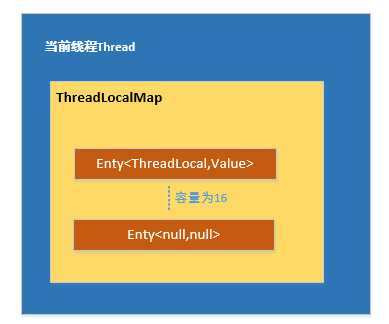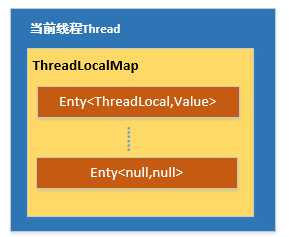赌十包辣条,你一定没见过这么透彻的ThreadLocal讲解
Posted andy-songwei
tags:
篇首语:本文由小常识网(cha138.com)小编为大家整理,主要介绍了赌十包辣条,你一定没见过这么透彻的ThreadLocal讲解相关的知识,希望对你有一定的参考价值。
如果转载请声明,转自【https://www.cnblogs.com/andy-songwei/p/12040372.html】,谢谢!
本文的主要内容为:

1、一个生活中的场景
鉴于普罗大众都喜欢看热闹,咱们先来看个热闹再开工吧!

场景一:
中午了, 张三、李四和王五一起去食堂大菜吃饭。食堂刚经营不久,还很简陋,负责打菜的只有一位老阿姨。
张三:我要一份鸡腿。
李四:我要一份小鸡炖蘑菇。
张三:我再要一份红烧肉。
王五:我要一份红烧排骨。
李四:我不要小鸡炖蘑菇了,换成红烧鲫鱼。
王五:我再要一份椒盐虾。
张三:我再要一份梅菜扣肉。
......
张三:我点的红烧肉,为啥给我打红烧鲫鱼?
李四:我的红烧鲫鱼呢?
王五:我有点红烧肉吗?
......
李四:我点了15元的菜,为啥扣我20?
王五:我点了20元的菜,只扣了我15元,赚了,窃喜!
张三:我已经刷了卡了,怎么还叫我刷卡?
......
老阿姨毕竟上了年纪,不那么利索,这几个小伙子咋咋呼呼,快言快语,老阿姨也被搅晕了,手忙脚乱,忙中出错,这仨小伙也是怨声载道。
场景二:
食堂领导看到这个场景,赶紧要求大家排队,一个一个来。后来,老阿姨轻松多了,也没有再犯错了。
但是,新的问题又来了,打菜的人当中,很多妹子很磨叽,点个菜犹犹豫豫想半天。
张三:太慢了,我快饿死了!
李四:再这么慢,下次去别家!
王五:我等得花儿都谢啦!
赵六:啥?我点了啥菜,花了多少钱,其它人怎么都知道?是阿姨多嘴了,还是其它人偷偷关注我很久了?太不安全了,一点隐私都没有,以后不来了。
......
场景三:
领导听到这些怨言,心里很不是滋味,大手一挥:扩大经营,以后为你们每一个人开一个流动窗口并请一位私人阿姨,只为你一个人服务!
从此,再也没有怨言,阿姨也没有再犯错了,皆大欢喜......
场景一就像多个线程同时去操作一个数据,最终的结果就是混乱。于是出现了同步锁synchronized,同一时刻只运行一个线程操作,就像场景二,大家先来后到排队,混乱的问题解决了。但是此时一个线程在操作的时候,其它线程只能闲等着,而且这些数据是共享的,每个线程希望拥有只能自己操作的私人数据,ThreadLocal就正好满足了这个需求。
所以,相比于synchronized,Threadlocal通过牺牲空间来换取时间和效率。
2、ThreadLocal简介
ThreadLocal官方的介绍为:
1 /** 2 * This class provides thread-local variables. These variables differ from 3 * their normal counterparts in that each thread that accesses one (via its 4 * {@code get} or {@code set} method) has its own, independently initialized 5 * copy of the variable. {@code ThreadLocal} instances are typically private 6 * static fields in classes that wish to associate state with a thread (e.g., 7 * a user ID or Transaction ID). 8 */
大致意思是:ThreadLocal提供了线程本地变量。这些变量与一般变量相比,其不同之处在于,通过它的get()和set()方法,每个线程可以访问自己独立拥有的初始变量副本。翻译成人话就是,ThreadLocal为每一个线程开辟了一个独立的存储器,只有对应的线程才能够访问其数据,其它线程则无法访问。对应于前文的场景,就像食堂为每一个人安排了一个窗口和专属阿姨为其打菜,这个过程中,这个窗口和阿姨就是其专属的独立的资源,其他人就无从知道他点了什么菜,花了多少钱。
3、ThreadLocal的简单使用示例
是骡子是马,先拉出来溜溜!先直观看看它的能耐,再来了解它丰富的内心:
1 // =========实例3.1======== 2 private ThreadLocal<String> mThreadLocal = new ThreadLocal<>(); 3 private void testThreadLocal() throws InterruptedException { 4 mThreadLocal.set("main-thread"); 5 Log.i("threadlocaldemo", "result-1=" + mThreadLocal.get()); 6 Thread thread_1 = new Thread() { 7 @Override 8 public void run() { 9 super.run(); 10 mThreadLocal.set("thread_1"); 11 Log.i("threadlocaldemo", "result-2=" + mThreadLocal.get()); 12 } 13 }; 14 thread_1.start(); 15 //该句表示thread_1执行完后才会继续执行 16 thread_1.join(); 17 Thread thread_2 = new Thread() { 18 @Override 19 public void run() { 20 super.run(); 21 Log.i("threadlocaldemo", "result-3=" + mThreadLocal.get()); 22 } 23 }; 24 thread_2.start(); 25 //该句表示thread_2执行完后才会继续执行 26 thread_2.join(); 27 Log.i("threadlocaldemo", "result-4=" + mThreadLocal.get()); 28 }
在主线程中调用这个方法,运行结果:
1 12-13 13:42:50.117 25626-25626/com.example.demos I/threadlocaldemo: result-1=main-thread 2 12-13 13:42:50.119 25626-25689/com.example.demos I/threadlocaldemo: result-2=thread_1 3 12-13 13:42:50.119 25626-25690/com.example.demos I/threadlocaldemo: result-3=null 4 12-13 13:42:50.120 25626-25626/com.example.demos I/threadlocaldemo: result-4=main-thread
看到这个结果会不会惊掉下巴呢?明明在第9行中set了值,第10行中也得到了对应的值,但第20行的get得到的却是null,第26行得到的是第3行set的值。这就是ThreadLocal的神奇功效,主线程set的值,只能在主线程get到;thread_1内部set的值,thread_1中才能get;thread_2中没有set,所以get到的就是null。
而实现这,不要999,也不要99,只要3......三步即可:
1 ThreadLocal<T> mThreadLocal = new ThreadLocal<>(); 2 mThreadLocal.set(T); 3 mThreadLocal.get();
就是这么方便,就是这么简洁!
4、提供的4个主要接口
ThreadLocal以其使用简单,风格简洁让人一见倾心。它对外提供的接口很少,当前SDK中,主要有4个:
1 public void set(T value) { } 2 public T get() { } 3 public void remove() { } 4 protected T initialValue() { }
为了保持对这些方法说明的原滋原味,我们直接通过源码中对其的注释说明来认识它们。
(1)set()
1 /** 2 * Sets the current thread‘s copy of this thread-local variable 3 * to the specified value. Most subclasses will have no need to 4 * override this method, relying solely on the {@link #initialValue} 5 * method to set the values of thread-locals. 6 * 7 * @param value the value to be stored in the current thread‘s copy of 8 * this thread-local. 9 */ 10 public void set(T value)
设置当前线程的ThreadLocal值为指定的value。大部分子类没有必要重写该方法,可以依赖initialValue()方法来设置ThreadLocal的值。
(2)get()
1 /** 2 * Returns the value in the current thread‘s copy of this 3 * thread-local variable. If the variable has no value for the 4 * current thread, it is first initialized to the value returned 5 * by an invocation of the {@link #initialValue} method. 6 * 7 * @return the current thread‘s value of this thread-local 8 */ 9 public T get()
用于获取当前线程所对应的ThreadLocal值。如果当前线程下,该变量没有值,会通过调用initialValue()方法返回的值对其进行初始化。
(3)remove()
1 /** 2 * Removes the current thread‘s value for this thread-local 3 * variable. If this thread-local variable is subsequently 4 * {@linkplain #get read} by the current thread, its value will be 5 * reinitialized by invoking its {@link #initialValue} method, 6 * unless its value is {@linkplain #set set} by the current thread 7 * in the interim. This may result in multiple invocations of the 8 * {@code initialValue} method in the current thread. 9 * 10 * @since 1.5 11 */ 12 public void remove()
该接口是从JDK1.5开始提供的,用于删除当前线程对应的ThreadLocal值,从而减少内存占用。在同一线程中,如果该方法被调用了,随后再调用get()方法时,会使得initialValue()被调用,从而ThreadLocal的值被重新初始化,除非此时在调用get()前调用了set()来赋值。该方法可能导致initialValue()被多次调用。该方法可以不用显示调用,因为当线程结束后,系统会自动回收线程局部变量值。所以该方法不是必须调用的,只不过显示调用可以加快内存回收。
(4)initialValue()
1 /** 2 * Returns the current thread‘s "initial value" for this 3 * thread-local variable. This method will be invoked the first 4 * time a thread accesses the variable with the {@link #get} 5 * method, unless the thread previously invoked the {@link #set} 6 * method, in which case the {@code initialValue} method will not 7 * be invoked for the thread. Normally, this method is invoked at 8 * most once per thread, but it may be invoked again in case of 9 * subsequent invocations of {@link #remove} followed by {@link #get}. 10 * 11 * <p>This implementation simply returns {@code null}; if the 12 * programmer desires thread-local variables to have an initial 13 * value other than {@code null}, {@code ThreadLocal} must be 14 * subclassed, and this method overridden. Typically, an 15 * anonymous inner class will be used. 16 * 17 * @return the initial value for this thread-local 18 */ 19 protected T initialValue() { 20 return null; 21 }
返回当前线程对应的ThreadLocal的初始值。当当前线程是通过get()方法第一次对ThreadLocal进行访问时,该方法将会被调用,除非当前线程之前调用过set()方法,在这种情况下initialValue()方法将不会被当前线程所调用。一般而言,该方法最多只会被每个线程调用一次,除非随后在当前线程中调用remove()方法,然后调用get()方法。该实现会简单地返回null;如果程序员希望ThreadLocal拥有一个初始值,而不是null,ThreadLocal需要定义一个子类,并且在子类中重写initialValue()方法。比较典型的做法是使用一个匿名内部类。该方法由protected修饰,可见其这样设计通常是为了供用户重写,从而自定义初始值。后面会再通过实例来演示该方法的使用。
5、ThreadLocal工作机制
ThreadLocal使用起来非常简单,但它是如何实现为每一个Thread保存一份独立的数据的呢?我们先结合实例3.1来看set()方法都做了些什么:
1 //=========ThreadLocal=======源码5.1 2 public void set(T value) { 3 Thread t = Thread.currentThread(); 4 ThreadLocalMap map = getMap(t); 5 if (map != null) 6 map.set(this, value); 7 else 8 createMap(t, value); 9 }
首先就是获取当前的线程,然后根据当前线程来获取一个ThreadLocalMap,如果map不为null,就往map中插入指定值,注意这的key是ThreadLocal实例;如果map为null,就创建一个map。看看第4行getMap(t)做了啥:
1 //=========ThreadLocal=======源码5.2 2 /** 3 * Get the map associated with a ThreadLocal. 4 * ...... 5 */ 6 ThreadLocalMap getMap(Thread t) { 7 return t.threadLocals; 8 } 9 10 /** 11 * ThreadLocalMap is a customized hash map suitable only for 12 * maintaining thread local values...... 13 */ 14 static class ThreadLocalMap { 15 ...... 16 } 17 18 //==========Thread======== 19 ThreadLocal.ThreadLocalMap threadLocals = null;
getMap()返回的是指定线程(也就是当前线程)的threadLocals变量,这个变量是ThreadLocal.ThreadLocalMap类型的,而ThreadLocalMap是一个仅适用于维护线程本地变量值的自定义的HashMap。简单来说,就是返回当前线程下的一个自定义HashMap。
下面我抽取了ThreadLocalMap的部分代码,先来总体上认识它(这里我们不需要读懂其中的每一行代码,知道它里面主要做了哪些事就可以了):

1 //=========源码5.3======== 2 static class ThreadLocalMap { 3 4 static class Entry extends WeakReference<ThreadLocal<?>> { 5 /** The value associated with this ThreadLocal. */ 6 Object value; 7 8 Entry(ThreadLocal<?> k, Object v) { 9 super(k); 10 value = v; 11 } 12 } 13 14 /** 15 * The initial capacity -- MUST be a power of two. 16 */ 17 private static final int INITIAL_CAPACITY = 16; 18 19 /** 20 * The table, resized as necessary. 21 * table.length MUST always be a power of two. 22 */ 23 private Entry[] table; 24 25 /** 26 * The number of entries in the table. 27 */ 28 private int size = 0; 29 30 /** 31 * The next size value at which to resize. 32 */ 33 private int threshold; // Default to 0 34 35 /** 36 * Set the resize threshold to maintain at worst a 2/3 load factor. 37 */ 38 private void setThreshold(int len) { 39 threshold = len * 2 / 3; 40 } 41 42 ThreadLocalMap(ThreadLocal<?> firstKey, Object firstValue) { 43 table = new Entry[INITIAL_CAPACITY]; 44 int i = firstKey.threadLocalHashCode & (INITIAL_CAPACITY - 1); 45 table[i] = new Entry(firstKey, firstValue); 46 size = 1; 47 setThreshold(INITIAL_CAPACITY); 48 } 49 50 /** 51 * Get the entry associated with key. 52 * ...... 53 */ 54 private Entry getEntry(ThreadLocal<?> key) { 55 int i = key.threadLocalHashCode & (table.length - 1); 56 Entry e = table[i]; 57 if (e != null && e.get() == key) 58 return e; 59 else 60 return getEntryAfterMiss(key, i, e); 61 } 62 63 /** 64 * Set the value associated with key. 65 * ...... 66 */ 67 private void set(ThreadLocal<?> key, Object value) { 68 69 // We don‘t use a fast path as with get() because it is at 70 // least as common to use set() to create new entries as 71 // it is to replace existing ones, in which case, a fast 72 // path would fail more often than not. 73 74 Entry[] tab = table; 75 int len = tab.length; 76 int i = key.threadLocalHashCode & (len-1); 77 78 for (Entry e = tab[i]; 79 e != null; 80 e = tab[i = nextIndex(i, len)]) { 81 ThreadLocal<?> k = e.get(); 82 83 if (k == key) { 84 e.value = value; 85 return; 86 } 87 88 if (k == null) { 89 replaceStaleEntry(key, value, i); 90 return; 91 } 92 } 93 94 tab[i] = new Entry(key, value); 95 int sz = ++size; 96 if (!cleanSomeSlots(i, sz) && sz >= threshold) 97 rehash(); 98 } 99 100 /** 101 * Remove the entry for key. 102 */ 103 private void remove(ThreadLocal<?> key) { 104 Entry[] tab = table; 105 int len = tab.length; 106 int i = key.threadLocalHashCode & (len-1); 107 for (Entry e = tab[i]; 108 e != null; 109 e = tab[i = nextIndex(i, len)]) { 110 if (e.get() == key) { 111 e.clear(); 112 expungeStaleEntry(i); 113 return; 114 } 115 } 116 } 117 118 /** 119 * Double the capacity of the table. 120 */ 121 private void resize() { 122 ...... 123 } 124 }
这里面维护了一个Entry[] table数组,初始容量为16,当数据超过当前容量的2/3时,就开始扩容,容量增大一倍。每一个Entry的K为ThreadLocal对象,V为要存储的值。每一个Entry在数组中的位置,是根据其K(即ThreadLocal对象)的hashCode & (len - 1)来确定,如第44行所示,这里K的hashCode是系统给出的一个算法计算得到的。如果碰到K的hashCode值相同,即hash碰撞的场景,会采用尾插法形成链表。当对这个map进行set,get,remove操作的时候,也是通过K的hashCode来确定该Entry在table中的位置的,采用hashCode来查找数据,效率比较高。这也是HashMap底层实现的基本原理,如果研究过HashMap源码,这段代码就应该比较容易理解了。
继续看源码5.1,第一次调用的时候,显然map应该是null,就要执行第8行createMap了,
1 //==========ThreadLocal=========源码5.4 2 void createMap(Thread t, T firstValue) { 3 t.threadLocals = new ThreadLocalMap(this, firstValue); 4 }
结合ThreadLocalMap源码第41行的构造方法,就清楚了这个方法创建了一个ThreadLocalMap对象,并存储了一个Entry<当前的ThreadLocal对象,value>。此时,在当前的线程下拥有了一个ThreadLocalMap,这个ThreadLocalMap中维护了一个容量为16的table,table中存储了一个以当前的ThreadLocal对象为K,value值为V的Entry。Thread、ThreadLocalMap、ThreadLocal、Entry之间的关系可以表示为下图:

图5.1
而如果当前Thread的map已经存在了,源码5.1就会执行第6行了,进而执行ThreadLocalMap中的set方法。结合前面对ThreadLocalMap的介绍,想必这个set方法也容易理解了,大致过程是:
1)根据Thread找到map;
2)通过传入的this(即ThreadLocal对象),得到hashCode;
3)根据hashCode & (len - 1)确定对应Entry在table中的位置;
4)如果该Entry存在,则替换Value,否则新建(ThreadLocalMap源码第78~92行表示在具有相同hashCode的Entry链表上找到对应的Entry,这和hash碰撞有关)。
在调用ThreadLocal的get方法时又做了什么呢?看看其源码:
1 //=========ThreadLocal======源码5.5 2 public T get() { 3 Thread t = Thread.currentThread(); 4 ThreadLocalMap map = getMap(t); 5 if (map != null) { 6 ThreadLocalMap.Entry e = map.getEntry(this); 7 if (e != null) { 8 @SuppressWarnings("unchecked") 9 T result = (T)e.value; 10 return result; 11 } 12 } 13 return setInitialValue(); 14 }
现在,第12行及以前的代码应该很容易理解了,结合ThreadLocalMap中的get源码,我们再梳理一下:
1)根据Thread找到自己的map;
2)在map中通过this(即ThreadLocal对象)得到hashCode;
3)通过hashCode & (len-1)找到对应Entry在table中的位置;
4)返回Entry的value。
而如果map为null,或者在map中找到的Entry为null,那么就执行第20行了。
1 //==========ThreadLocal========源码5.6 2 private T setInitialValue() { 3 T value = initialValue(); 4 Thread t = Thread.currentThread(); 5 ThreadLocalMap map = getMap(t); 6 if (map != null) 7 map.set(this, value); 8 else 9 createMap(t, value); 10 return value; 11 } 12 13 protected T initialValue() { 14 return null; 15 }
第13行的initialValue()方法,前面介绍过,可以让子类重写,即给ThreadLocal指定初始值;如果没有重写,那返回值就是null。第4~9行前面也介绍过了,使用或者创建map来存入该值。
最后还一个remove()方法
1 //======ThreadLocal====== 2 public void remove() { 3 ThreadLocalMap m = getMap(Thread.currentThread()); 4 if (m != null) 5 m.remove(this); 6 }
结合ThrealLocalMap中的remove方法,完成对ThreadLocal值的删除。其大致流程为:
1)根据当前Thread找到其map;
2)根据ThreadLocal对象得到hashCode;
3)通过hashCode & (len -1)找到在table中的位置;
4)在table中查找对应的Entry,如果存在则删除。
总结:通过对提供的4个接口方法的分析,我们应该就能清楚了,ThreadLocal之所以能够为每一个线程维护一个副本,是因为每个线程都拥有一个map,这个map就是每个线程的专属空间。也就是存在下面的关系图(不用怀疑,该图和图5.1相比,只是少了容量大小):

结合这一节对ThreadLocal机制的介绍,实例3.1执行后的就存在如下的数据结构了:

6、ThreadLocal在Looper中的使用
ThreadLocal在系统源码中有很多地方使用,最典型的地方就是Handler的Looper中了。这里结合Looper中的源码,来了解一下ThreadLocal在系统源码中的使用。
我们知道,在一个App进程启动的时候,会在ActiivtyThread类的main方法,也就是App的入口方法中,会为主线程准备一个Looper,如下代码所示:
1 //======ActivityTread======源码6.1 2 public static void main(String[] args) { 3 ...... 4 Looper.prepareMainLooper(); 5 ...... 6 }
而在子线程中实例Handler的时候,总是需要显示调用Looper.prepare()方法来为当前线程生成一个Looper对象,以及通过Looper.myLooper()来得到自己线程的Looper来传递给Handler。
Looper中相关的关键源码如下:
1 //==========Looper========源码6.2 2 3 // sThreadLocal.get() will return null unless you‘ve called prepare(). 4 static final ThreadLocal<Looper> sThreadLocal = new ThreadLocal<Looper>(); 5 private static Looper sMainLooper; 6 7 /** 8 * Initialize the current thread as a looper, marking it as an 9 * application‘s main looper. The main looper for your application 10 * is created by the android environment, so you should never need 11 * to call this function yourself. See also: {@link #prepare()} 12 */ 13 public static void prepareMainLooper() { 14 prepare(false); 15 synchronized (Looper.class) { 16 if (sMainLooper != null) { 17 throw new IllegalStateException("The main Looper has already been prepared."); 18 } 19 sMainLooper = myLooper(); 20 } 21 } 22 23 /** 24 * Return the Looper object associated with the current thread. Returns 25 * null if the calling thread is not associated with a Looper. 26 */ 27 public static @Nullable Looper myLooper() { 28 return sThreadLocal.get(); 29 } 30 31 /** Initialize the current thread as a looper. 32 * ...... 33 */ 34 public static void prepare() { 35 prepare(true); 36 } 37 private static void prepare(boolean quitAllowed) { 38 if (sThreadLocal.get() != null) { 39 throw new RuntimeException("Only one Looper may be created per thread"); 40 } 41 sThreadLocal.set(new Looper(quitAllowed)); 42 } 43 44 /** 45 * Returns the application‘s main looper, which lives in the main thread of the application. 46 */ 47 public static Looper getMainLooper() { 48 synchronized (Looper.class) { 49 return sMainLooper; 50 } 51 }
我们可以看到不少ThreadLocal的影子,Looper也正是通过ThreadLocal来为每个线程维护一份Looper实例的。通过我们前文的介绍,这里应该能够轻而易举理解其中的运作机制了吧,这里就再不啰嗦了。
7、实践是检验真理的唯一标准
前面介绍了ThreadLocal提供的四个接口,以及详细讲解了它的工作原理。现在我们将实例3.1做一些修改,将各个接口的功能都包含进来,并稍微增加一点复杂度,如果能够看懂这个实例,就算是真的理解ThreadLocal了。
1 //=========实例7.1======= 2 private ThreadLocal<String> mStrThreadLocal = new ThreadLocal<String>() { 3 @Override 4 protected String initialValue() { 5 Log.i("threadlocaldemo", "initialValue"); 6 return "initName"; 7 } 8 }; 9 private ThreadLocal<Long> mLongThreadLocal = new ThreadLocal<>(); 10 private void testThreadLocal() throws InterruptedException { 11 mStrThreadLocal.set("main-thread"); 12 mLongThreadLocal.set(Thread.currentThread().getId()); 13 Log.i("threadlocaldemo", "result-1:name=" + mStrThreadLocal.get() + ";id=" + mLongThreadLocal.get()); 14 Thread thread_1 = new Thread() { 15 @Override 16 public void run() { 17 super.run(); 18 mStrThreadLocal.set("thread_1"); 19 mLongThreadLocal.set(Thread.currentThread().getId()); 20 Log.i("threadlocaldemo", "result-2:name=" + mStrThreadLocal.get() + ";id=" + mLongThreadLocal.get()); 21 } 22 }; 23 thread_1.start(); 24 //该句表示thread_1执行完后才会继续执行 25 thread_1.join(); 26 Thread thread_2 = new Thread() { 27 @Override 28 public void run() { 29 super.run(); 30 Log.i("threadlocaldemo", "result-3:name=" + mStrThreadLocal.get() + ";id=" + mLongThreadLocal.get()); 31 } 32 }; 33 thread_2.start(); 34 //该句表示thread_2执行完后才会继续执行 35 thread_2.join(); 36 mStrThreadLocal.remove(); 37 Log.i("threadlocaldemo", "result-4:name=" + mStrThreadLocal.get() + ";id=" + mLongThreadLocal.get()); 38 }
在主线程中运行该方法,执行结果为:
1 12-14 16:25:40.662 4844-4844/com.example.demos I/threadlocaldemo: result-1:name=main-thread;id=2 2 12-14 16:25:40.668 4844-5351/com.example.demos I/threadlocaldemo: result-2:name=thread_1;id=926 3 12-14 16:25:40.669 4844-5353/com.example.demos I/threadlocaldemo: initialValue 4 12-14 16:25:40.669 4844-5353/com.example.demos I/threadlocaldemo: result-3:name=initName;id=null 5 12-14 16:25:40.669 4844-4844/com.example.demos I/threadlocaldemo: initialValue 6 12-14 16:25:40.669 4844-4844/com.example.demos I/threadlocaldemo: result-4:name=initName;id=2
此时存在的数据结构为:

对于这份log和数据结构图,这里就不再一一讲解了,如果前面都看懂了,这些都是小菜一碟。
结语
对ThreadLocal的讲解这里就结束了,能读到这里,也足以说明你是人才,一定前途无量,祝你好运,早日走上人生巅峰!
由于经验和水平有限,有描述不当或不准确的地方,还请不吝赐教,谢谢!
以上是关于赌十包辣条,你一定没见过这么透彻的ThreadLocal讲解的主要内容,如果未能解决你的问题,请参考以下文章
